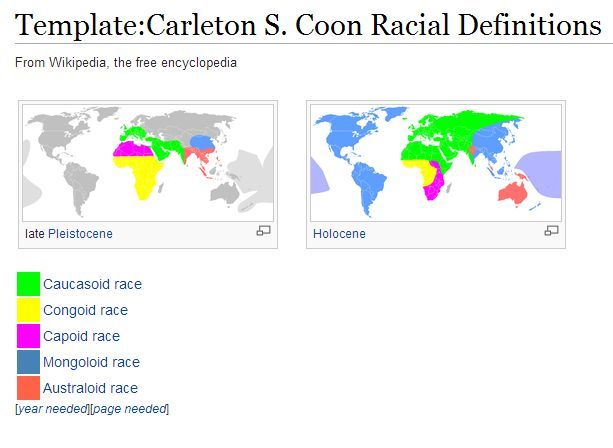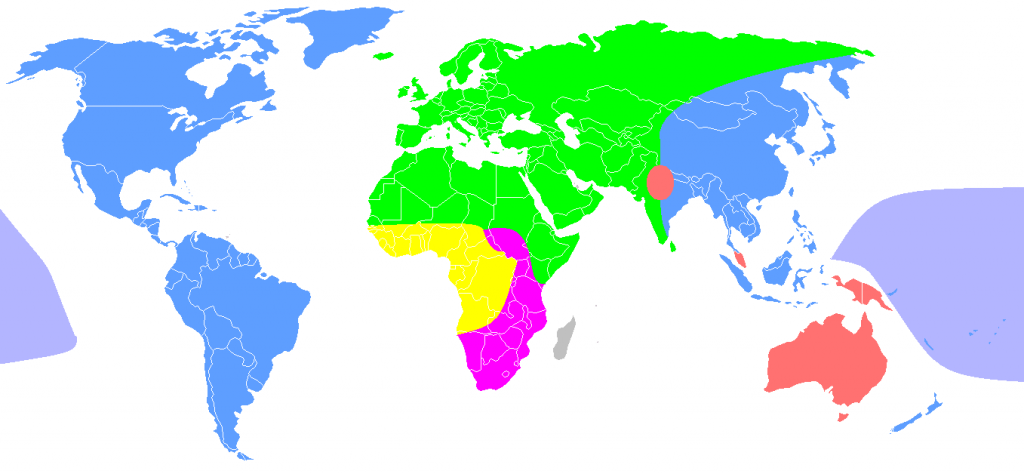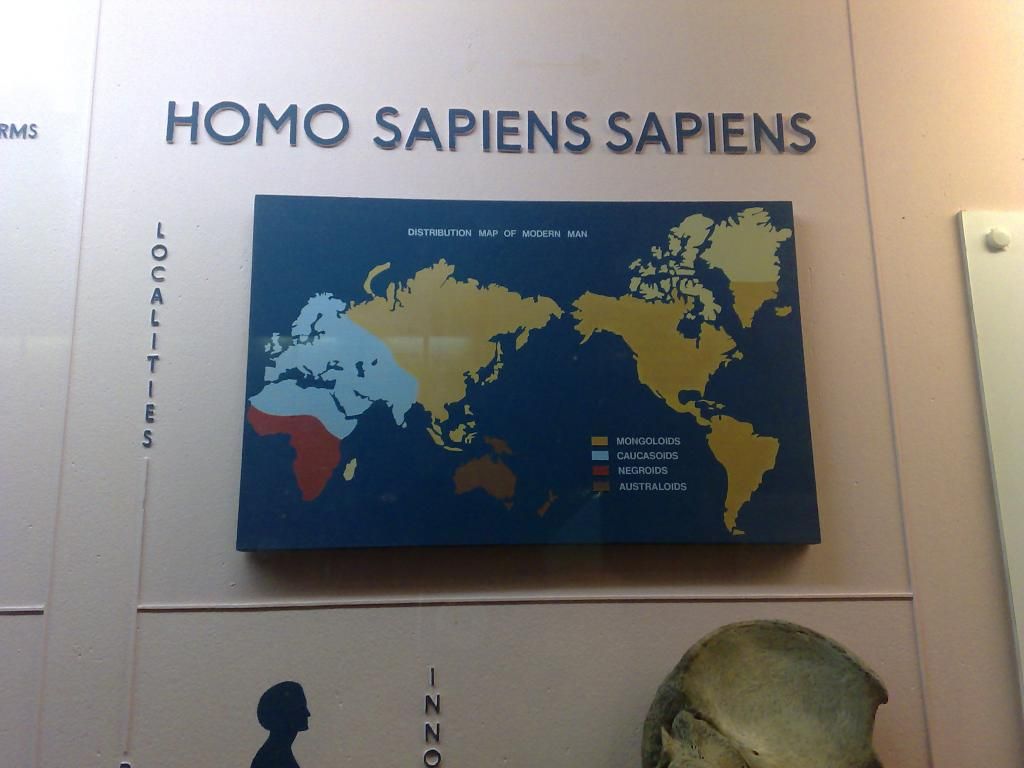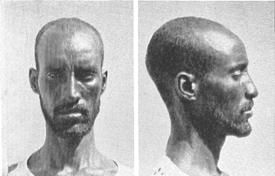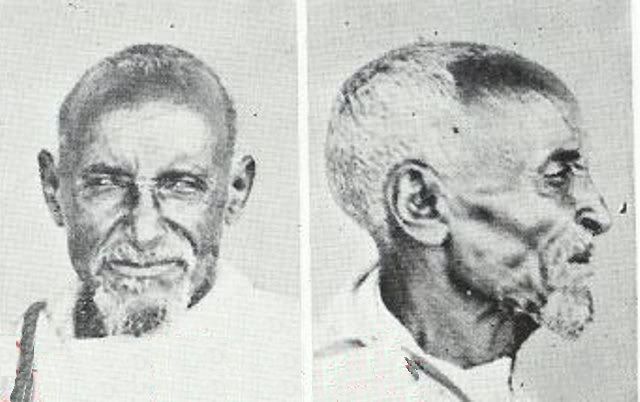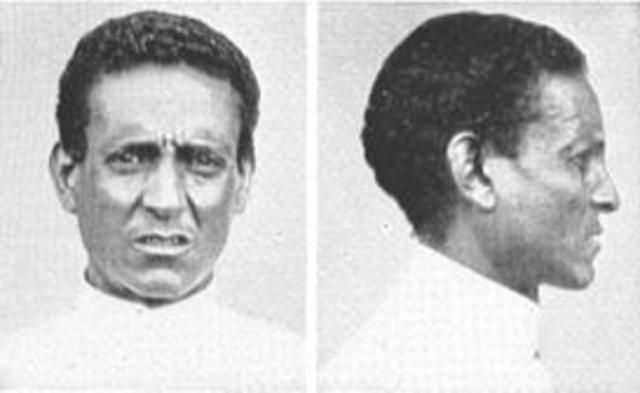Below is the definition and a map showing the global distribution of the Caucasoid(green) according to the anthropologist Carleton S. Coon, The Origin of Races
(1962), p. 108-109:
"This schematic map shows the distribution of the five subspecies of Homo during most of the Pleistocene, from 500,000 to 10,000 years ago. This distribution matches that on the diagram in Chapter 1. Of the five subspecies, the Congoid was the most isolated; it was in contact with only one other, the Capoid, then resident in North Africa. The second map shows what happened at the end of the Pleistocene, when the Mongoloids and Caucasoids expanded and burst out of their territories. The Mongoloids entered and inhabited America, and extended their domain southward into Southeast Asia and Indonesia, while the Australoids crossed Wallace's Line and occupied Australia and New Guinea. The Caucasoids thrust northward. More significantly, they drove the Capoids out of North Africa and occupied the White Highlands of Kenya and Tanganyika. The Congoids were reduced to a small part of their earlier domain, including the Congo forests and the lands to the north, where they later evolved rapidly and spread, as Negroes, over much of Africa."
Compare to display at the Horniman Museum:
From the chapter "The Negroid Periphery of the Mediterranean Race":“The different groups studied in Ethiopia share a tendency to dolichocephaly or mesocephaly, and to a narrow face form. In the measurements of the head and face, all are fundamentally Mediterranean, and the negroid traits manifested in the soft parts do not reveal themselves in the measurements, except in nose breadth and in the biorbital and interorbital diameters. The heads are larger than those of the Yemeni Mediterraneans; Amharas (in the sense of Semitic-speaking Abyssinians) have vault dimensions of 194 mm. (length) by 150 mm. (breadth) by 127 mm. (height); these figures could apply as well to Nordics as to Abyssinians.So far the inhabitants of the Abyssinian plateau, whatever their speech and ethnic origin, are dolichocephalic or mesocephalic, and comparable to Mediterraneans elsewhere, especially, as we shall later see, to North African Berbers, as well as to North European Nordics.Our Survey of the metrical characters of the inhabitants of the Hamitic racial area has brought several facts to light; the agricultural population of the Ethiopian highlands, both indigenous and imported from Arabia, belongs to a tall, dolichocephalic to mesocephalic, leptoprosopic, moderately leptorrhine race, which is Mediterranean in metrical position and cannot be distinguished, on the basis of the more commonly taken measurements, from blond and brunet Mediterraneans of Europe and North Africa. The Somalis, on the other hand, belong to an extreme racial form; extremely linear in bodily build, extremely narrow-headed and narrow-faced, with a special narrowness of the jaw. The relationship of the Somalis, on metrical grounds, is with some of the peoples of India as much as with the Mediterraneans elsewhere.On the whole, the white strain is much more numerous and much more important metrically, while in pigmentation and in hair form the negroid influence has made itself clearly seen. This study of Ethiopians and Somalis has served to bring out the principle that metrical similarities of a racial order have little reference to the soft parts, since Somalis, Gallas Arabs, Berbers, Norwegians, and Englishmen may all be closely related in measurements, and at the same time fall at world extremes in pigmentation and in hair form. Within the Mediterranean racial family there is every variation in these external features between a Nordic and a Somali.”
http://www.theapricity.com/snpa/troeplate20.htm
FIG. 1 (2 views). A Somali from the tribe of Mahmud Grade, British Somaliland. This Somali represents the closest approximation to a white man found among his people. The extreme narrowness of his head and face, the straight nasal profile, and the prominence of his chin, mark him as less negroid than many of his fellows. At the same time his skin is nearly black, his hair curly but not frizzly. The type to which this So- mali belongs is ancient in East Africa, as shown by the excavations of Leakey in Kenya. It is a specialized, locally differentiated Mediterranean racial form.
FIG. 2 (2 views). Closer to the standard Mediterranean type of Arabia and North Africa is this senile Agau, a member of a fast diminishing group of Hamitic-speaking aborigines in the kingdom of Gojjam in northern Ethiopia. Although his skin is dark, his hair is nearly straight, and his measurements as well as his cranial and facial fea- tures are purely or almost purely Mediterranean. He shows no visible signs of negroid admixture, although from a purely genetic standpoint some must be present.
FIG. 3 (2 views). This individual is a tall, slender Semitic-speaking Ethiopian from the kingdom of Shoa. Except for his hair form he is essentially white and Mediter- ranean. His skin is a sallow yellowish, of a hue often seen among attenuated negro- white hybrids in America.
